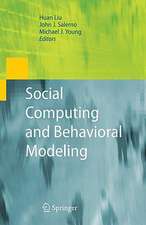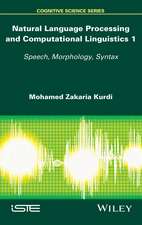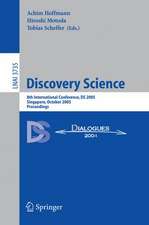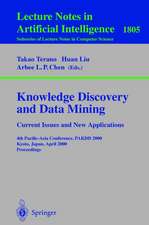Feature Selection for Knowledge Discovery and Data Mining: The Springer International Series in Engineering and Computer Science, cartea 454
Autor Huan Liu, Hiroshi Motodaen Limba Engleză Hardback – 31 iul 1998
| Toate formatele și edițiile | Preț | Express |
|---|---|---|
| Paperback (1) | 2179.74 lei 43-57 zile | |
| Springer Us – 27 ian 2013 | 2179.74 lei 43-57 zile | |
| Hardback (1) | 2184.02 lei 43-57 zile | |
| Springer Us – 31 iul 1998 | 2184.02 lei 43-57 zile |
Din seria The Springer International Series in Engineering and Computer Science
- 24%
 Preț: 1041.98 lei
Preț: 1041.98 lei - 20%
 Preț: 643.50 lei
Preț: 643.50 lei - 18%
 Preț: 1225.62 lei
Preț: 1225.62 lei - 18%
 Preț: 965.02 lei
Preț: 965.02 lei - 20%
 Preț: 646.12 lei
Preț: 646.12 lei - 18%
 Preț: 948.79 lei
Preț: 948.79 lei - 20%
 Preț: 646.62 lei
Preț: 646.62 lei - 15%
 Preț: 637.46 lei
Preț: 637.46 lei - 20%
 Preț: 643.83 lei
Preț: 643.83 lei - 18%
 Preț: 949.23 lei
Preț: 949.23 lei - 20%
 Preț: 644.48 lei
Preț: 644.48 lei - 20%
 Preț: 994.92 lei
Preț: 994.92 lei - 20%
 Preț: 645.97 lei
Preț: 645.97 lei - 18%
 Preț: 946.87 lei
Preț: 946.87 lei - 20%
 Preț: 995.57 lei
Preț: 995.57 lei - 18%
 Preț: 956.99 lei
Preț: 956.99 lei - 20%
 Preț: 644.98 lei
Preț: 644.98 lei - 15%
 Preț: 649.54 lei
Preț: 649.54 lei - 18%
 Preț: 950.21 lei
Preț: 950.21 lei - 18%
 Preț: 1221.38 lei
Preț: 1221.38 lei - 18%
 Preț: 957.62 lei
Preț: 957.62 lei - 15%
 Preț: 643.99 lei
Preț: 643.99 lei - 18%
 Preț: 948.47 lei
Preț: 948.47 lei - 18%
 Preț: 947.35 lei
Preț: 947.35 lei - 20%
 Preț: 1284.65 lei
Preț: 1284.65 lei - 20%
 Preț: 1628.31 lei
Preț: 1628.31 lei - 20%
 Preț: 1285.78 lei
Preț: 1285.78 lei
Preț: 2184.02 lei
Preț vechi: 2730.03 lei
-20% Nou
Puncte Express: 3276
Preț estimativ în valută:
418.04€ • 454.24$ • 351.38£
418.04€ • 454.24$ • 351.38£
Carte tipărită la comandă
Livrare economică 21 aprilie-05 mai
Preluare comenzi: 021 569.72.76
Specificații
ISBN-13: 9780792381983
ISBN-10: 079238198X
Pagini: 214
Ilustrații: XXIII, 214 p.
Dimensiuni: 155 x 235 x 19 mm
Greutate: 0.46 kg
Ediția:1998
Editura: Springer Us
Colecția Springer
Seria The Springer International Series in Engineering and Computer Science
Locul publicării:New York, NY, United States
ISBN-10: 079238198X
Pagini: 214
Ilustrații: XXIII, 214 p.
Dimensiuni: 155 x 235 x 19 mm
Greutate: 0.46 kg
Ediția:1998
Editura: Springer Us
Colecția Springer
Seria The Springer International Series in Engineering and Computer Science
Locul publicării:New York, NY, United States
Public țintă
ResearchCuprins
1. Data Processing and KDD.- 1.1 Inductive Learning from Observation.- 1.2 Knowledge Discovery and Data Mining.- 1.3 Feature Selection and Its Roles in KDD.- 1.4 Summary.- References.- 2. Perspectives of Feature Selection.- 2.1 Feature Selection for Classification.- 2.2 A Search Problem.- 2.3 Selection Criteria.- 2.4 Univariate vs. Multivariate Feature Selection.- 2.5 Filter vs. Wrapper Models.- 2.6 A Unified View.- 2.7 Conclusion.- References.- 3. Aspects of Feature Selection.- 3.1 Overview.- 3.2 Basic Feature Generation Schemes.- 3.3 Search Strategies.- 3.4 Evaluation Measures With Examples.- 3.5 Conclusion.- References.- 4. Feature Selection Methods.- 4.1 Representative Feature Selection Algorithms.- 4.2 Employing Feature Selection Methods.- 4.3 Conclusion.- References.- 5. Evaluation and Application.- 5.1 Performance Assessment.- 5.2 Evaluation Methods for Classification.- 5.3 Evaluation of Selected Features.- 5.4 Evaluation: Some Examples.- 5.5 Balance between Different Performance Criteria.- 5.6 Applying Feature Selection Methods.- 5.7 Conclusions.- References.- 6. Feature Transformation and Dimensionality Reduction.- 6.1 Feature Extraction.- 6.2 Feature Construction.- 6.3 Feature Discretization.- 6.4 Beyond the Classification Model.- 6.5 Conclusions.- References.- 7. Less is More.- 7.1 A Look Back.- 7.2 A Glance Ahead.- References.- Appendices.- A-Data Mining and Knowledge Discovery Sources.- A.1 Web Site Links.- A.2 Electronic Newsletters, Pages and Journals.- A.3 Some Publically Available Tools.- B-Data Sets and Software Used in This Book.- B.1 Data Sets.- B.2 Software.- References.
























